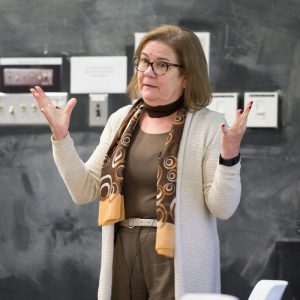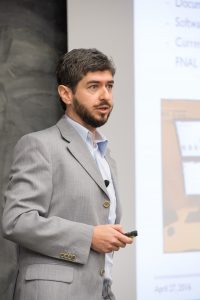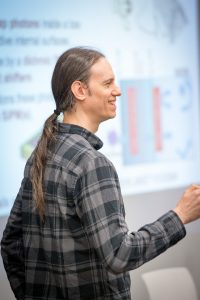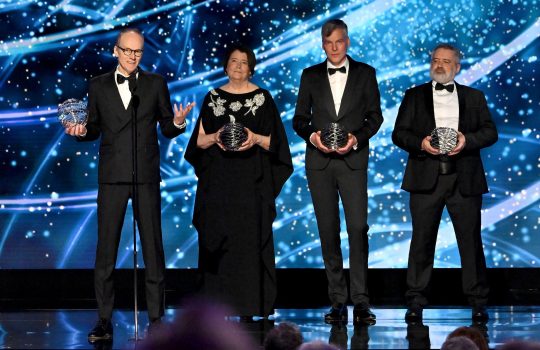On April 27 and 28, Fermilab hosted the Neutrino – Latin America Workshop for visiting scientists. The workshop showcased Latin American collaboration with the laboratory throughout the years, and scientists discussed research opportunities both here at Fermilab and at institutions in Central and South America.
“Our intention was to increase the awareness of the DUNE scientific and technical program and to highlight the many areas where Latin American scientists and engineers can make important contributions within DUNE and the broader Fermilab neutrino program, including the short-baseline neutrino experiments,” said Mark Thomson, a co-spokesperson for DUNE and lead organizer of the workshop. Latin America has a rich history in particle physics, and this workshop highlighted the projects that resulted from the longstanding relationship Fermilab has with these nations, he said.
The past
As early as the 1930s, physicists at institutions in Argentina, Brazil and Mexico were studying cosmic rays and theoretical particle physics. Several of these nations expanded their focus in particle physics, but at the time, programs were few, and funding was minimal. In the early 1980s, Leon Lederman, Fermilab’s second director, realized the potential benefits of a relationship between Fermilab and our neighbors to the south after attending several symposia hosted in Latin America. By 1984, Lederman sponsored four Brazilian physicists — the first Latin American scientists to come to Fermilab — to participate on a fixed-target experiment.

Fermilab Neutrino Division Head Regina Rameika, one of the workshop’s first speakers, gives an overview of the lab’s neutrino program and discusses the importance of building international relationships for particle physics. Photo: Reidar Hahn
“Lederman took a bold step with inviting us to join the experimental high-energy physics program at Fermilab,” said Carlos Escobar, a guest scientist in Fermilab’s Neutrino Division and one of the first four Brazilian physicists to join the lab. “We had physicists working in theory for high-energy physics groups in our home institutions but no experimental groups using accelerators in particle physics. We were the pioneering Latin Americans here at Fermilab.”
Shortly after this group joined the lab, they began to reach out to their students and colleagues at home to train them for future projects. More and more Latin American students and scientists from multiple countries gained opportunities to learn and work at Fermilab, and they eventually became a valuable group to the laboratory’s growing neutrino program.
The present
The first day of the April workshop included presentations and discussions about past neutrino experiments, right up to current projects. Latin America has collaborated with Fermilab on several projects over the years, including MINOS and MINOS+, MiniBooNE, LArIAT and NOvA.
According to Julian Felix, a professor of physics at the University of Guanajuato in Mexico, Latin Americans made up nearly a quarter of the MINERvA collaboration. The proposed CAPTAIN MINERvA experiment, which would be an expansion of its predecessor with a focus in neutrino-argon interaction studies, would continue the tradition of collaboration with Latin American institutions.
“The test beam for the MINERvA experiment was done by several Latin American students, and all of the students made a big difference in this work,” he said in his presentation. “This experiment had the largest contributions from Latin America of any experiment at Fermilab, and my students and I gained a lot of experience from it.”

Ricardo Gomes of the Federal University of Goias in Brazil worked on remote operations for MINOS and NOvA. His group specializes in simulation programs, such as CORSIKA, which has potential use for DUNE. Photo: Reidar Hahn
Today, the in-progress Short-Baseline Neutrino program, with three supporting experiments hunting for a fourth type of neutrino, currently has 55 collaborating institutions from eight countries. Three institutions are from Brazil and one is from Puerto Rico. Workshop participants in the SBN program took the opportunity to invite their Latin American colleagues to join SBN.
“We want to reach out to this specific region of the world because they are valuable and bring a variety of ideas and opinions to our work,” said Regina Rameika, head of Fermilab’s Neutrino Division. “We especially want students to participate so they can gain experience. New programs like SBN are great because students can start at the beginning of the project and see it progress.”
Several workshop participants said that, while experience abroad is valuable, it’s just as important that highly trained professionals who studied at Latin American universities and institutions make their skills and talents available in their home nations.
“Our governments and countries are willing to fund physicists and engineers,” Felix said. “We need skilled professionals in industry in our home countries.”
Rameika said Fermilab is a good training ground for Latin American students, who participate in a particle physics experiment before they head back to their nations to inspire others to become scientists.
“Fermilab could be a part of this loop in which we bring students here, offer them profound experience in their field and then send them back to build stronger programs back home,” she said.
At the workshop, physicists on new projects in Latin America informed and invited Fermilab scientists to participate. ANDES, for example, is an underground laboratory located on the borders between Argentina, Brazil and Chile. It will be one of the first multidisciplinary underground facilities in the Southern Hemisphere. And, CONNIE a neutrino-nucleus interaction experiment led by Fermilab scientist Juan Estrada and located in a nuclear power plant near Rio de Janeiro, Brazil, will produce data to help answer questions about the Standard Model and even test safety applications in nuclear facilities.
The future
On the second day of the workshop, the spotlight was on future opportunities and upcoming experiments.

Celio Moura, a physicist from the Federal University of ABC in Brazil, participated in Fermilab’s liquid-argon detection research. Moura said all of the neutrino experiments are linked: “When you learn the tools to do one experiment, you can go on to do many more.” Photo: Reidar Hahn
Fermilab’s future flagship experiment DUNE is among the world’s largest neutrino experiments, currently with 850 collaborators from 149 institutions in 29 countries. Presenters discussed opportunities in software, scientific computing, theory and accelerator engineering for DUNE. The research scope includes supernova neutrinos, neutrino oscillation, proton decay and the universe’s matter-antimatter imbalance.
Several Latin American institutions have developed simulation technologies capable of handling the amount of data DUNE would produce. This is one of the many key areas in which Latin American collaboration is vital to the lab.
“DUNE is an incredibly exciting international partnership and will be the next big thing in particle physics,” Thomson said. “We hope to build on the existing Latin American participation in DUNE and the rest of the Fermilab neutrino program. Latin American scientists bring great expertise, and DUNE is an opportunity to form scientific partnerships in the next major international neutrino experiment. There are many benefits, including providing training for the next generation of Latin American physicists.”
CERN’s ProtoDUNE, the large-scale DUNE prototypes, also has opportunities for Latin American scientists and engineers in Switzerland. CERN enjoys strong Latin American participation, with approximately 300 physicists from 12 nations, according to Gustavo Otero y Garzon, a assistant professor at the University of Buenos Aires in Argentina and a physicist on CERN’s ATLAS experiment.
In 2015, Fermilab had a total of 162 visiting Latin American scientists and students from eight countries contributing to several neutrino experiments.
“Latin America is developing and growing its economy, and this is a perfect opportunity for us to engage their local industry and institutions to develop new technologies and share their expertise,” Escobar said. “These nations share a passion for science with us and will be effective partners for us at the frontier of particle physics.”



